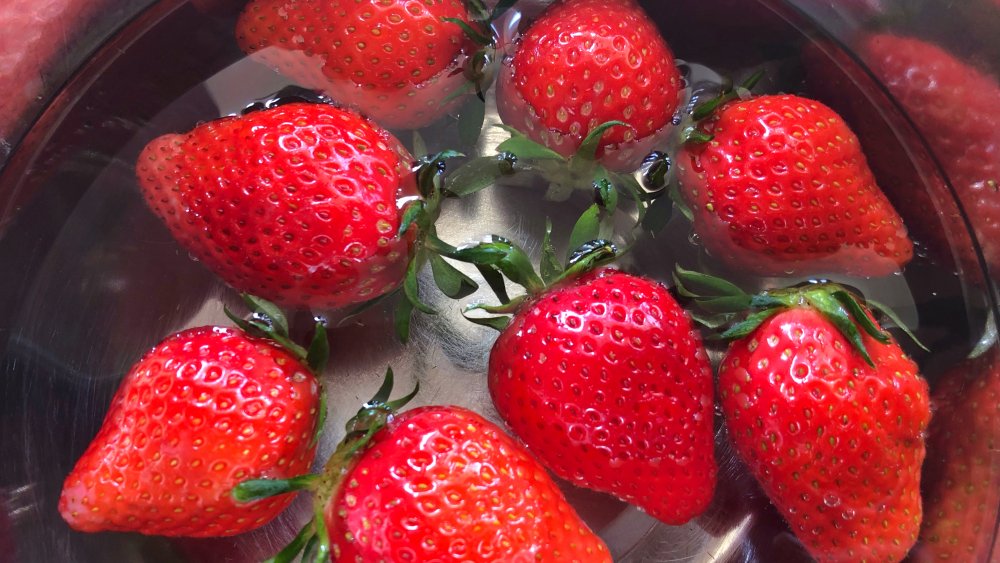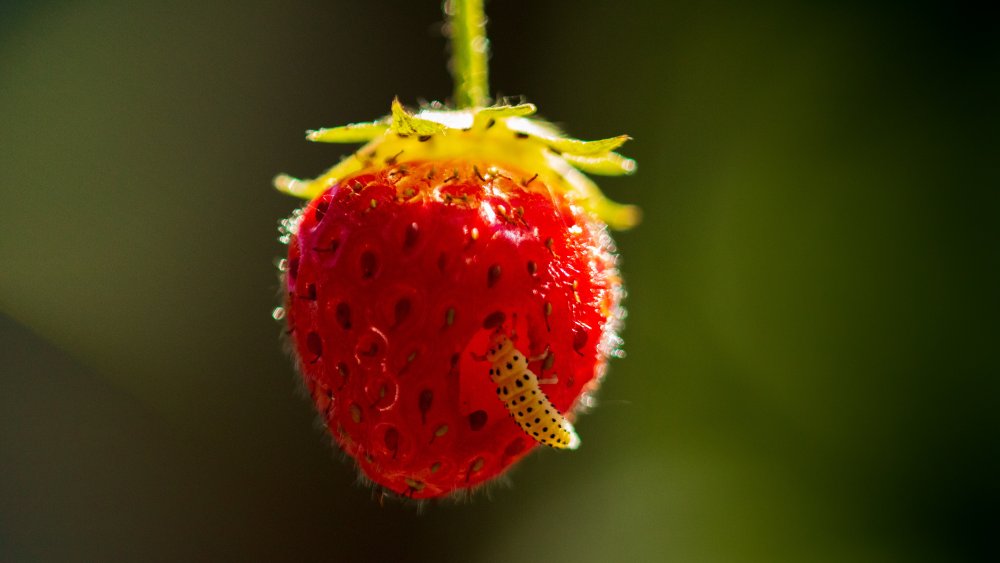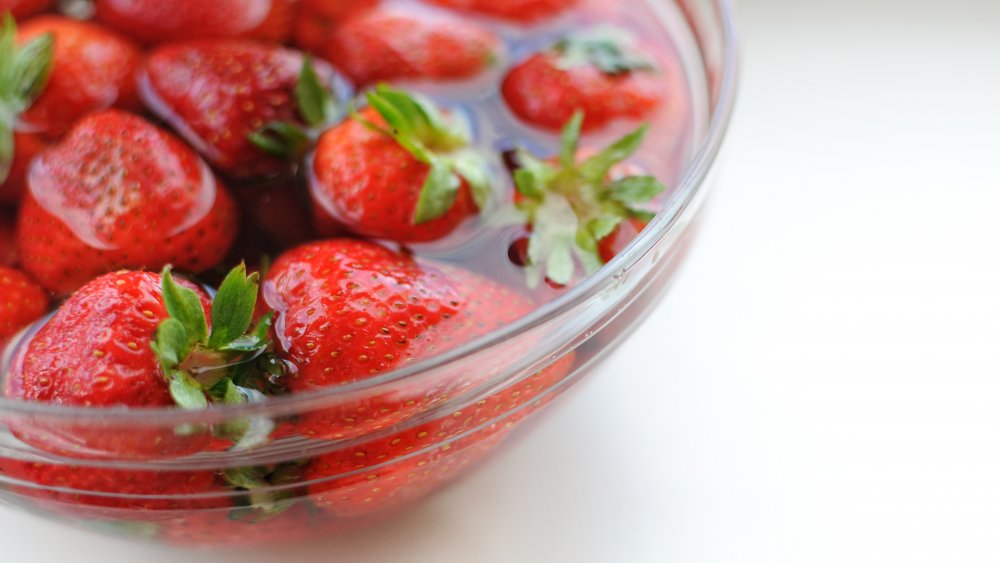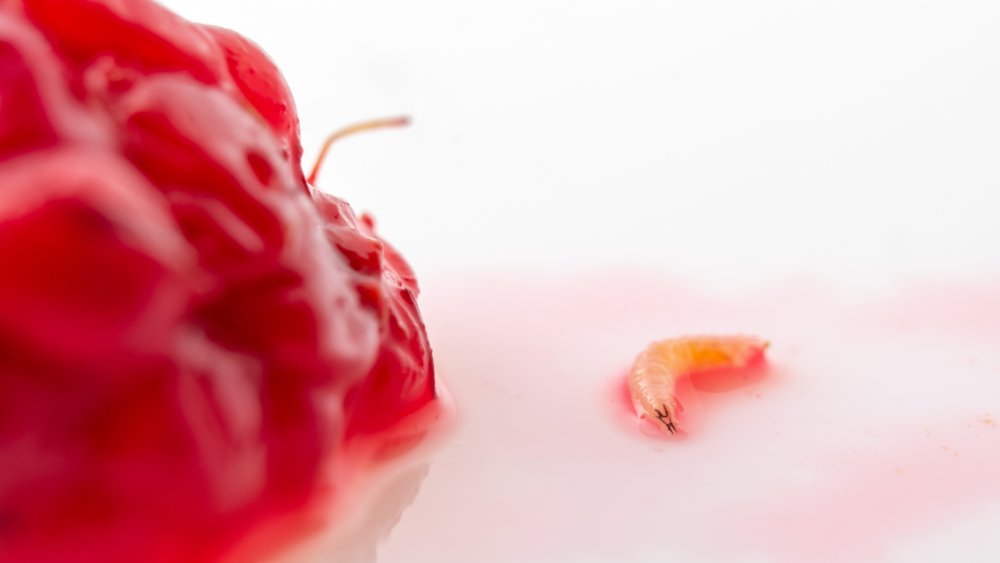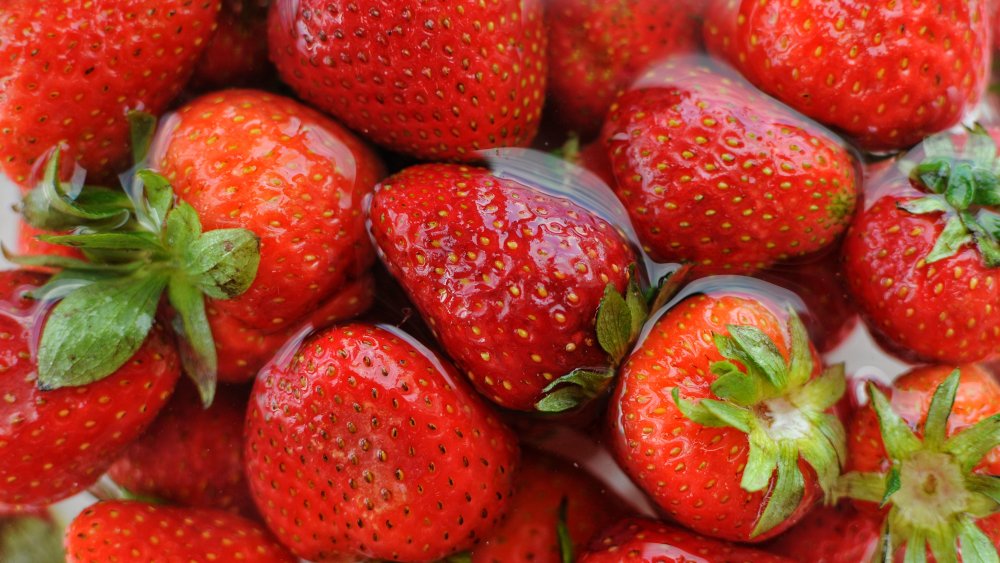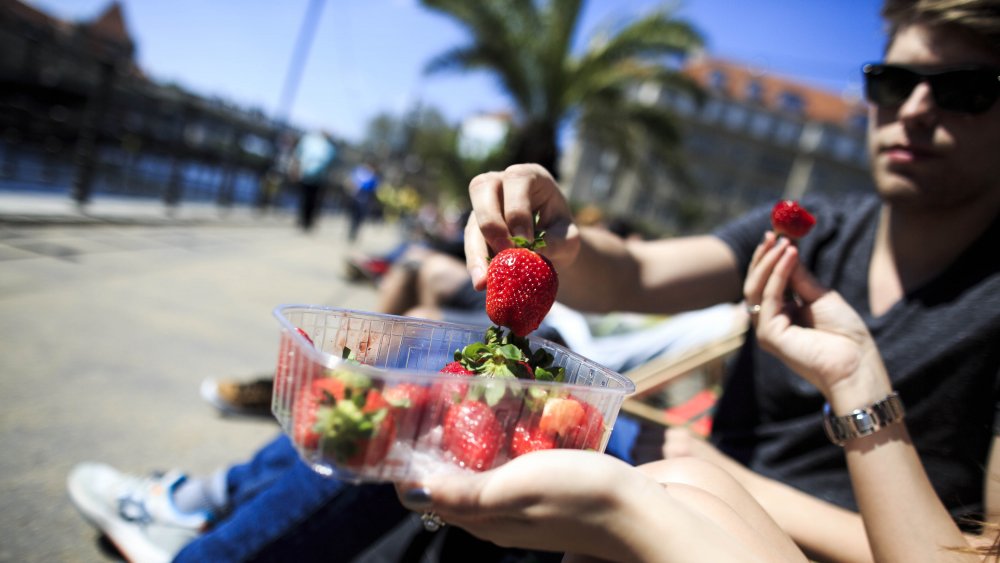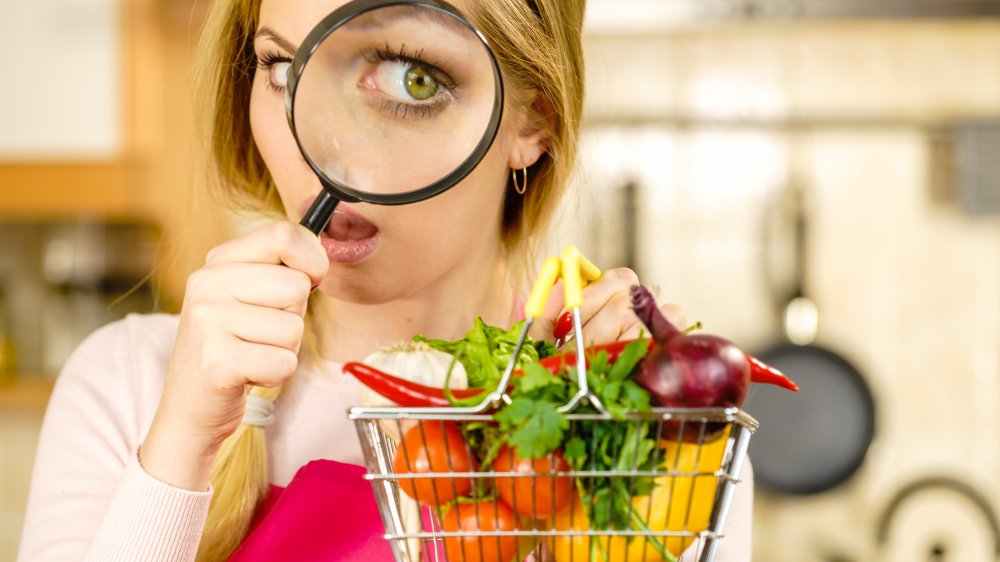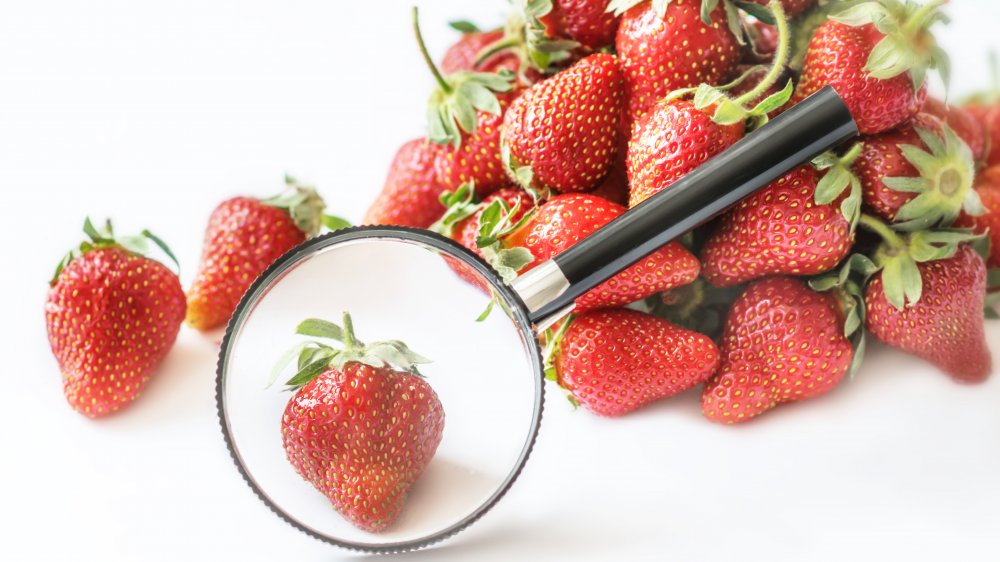The Gross Reason You Should Soak Your Strawberries In Salt Water
We all know that when it comes to hacks that are "guaranteed" to make your life easier (or simpler, healthier, better, or safer), many of them are exactly what you'd expect: a load of bologna. It's easy to scroll past them with a healthy dose of skepticism and know you're reading something that's just meant to go viral, and it's not actually important.
But sometimes, there's something that's just gross enough to stick in the back of your head, surfacing at night, showing up in your dreams, making you wonder if it really is possible.
Is it?
We are, of course, talking about that viral video that explains why you should soak your strawberries in salt water before eating them. It has everything a viral video needs, from a tip we can all use, to one of our favorite fruits, to a healthy helping of nastiness. So, what's the real story here? Let's find out.
Here's the viral claim about soaking strawberries in salt water
Let's start with the viral claim that started making the rounds on social media in spring of 2020. According to Newshub, it started when a series of videos started popping up, warning unsuspecting viewers that there was something living in their favorite fruits: tiny little worms.
Well, that got disgusting pretty quickly, didn't it?
The videos seemed to show perfectly ordinary-looking strawberries, with no signs of spoilage, rot, or alien invader-larvae. No signs, that is, until they were soaked in salt water. That's when some of the seeds started wiggling and the little worms started crawling out, and if that's not enough to ruin your strawberry shortcake, then nothing is.
And don't worry, it gets a tad more gross. Check out the TikTok tag #strawberrieswithbugs and you'll find that apparently, this isn't a one-time thing. So, so, so many people claim to have soaked their strawberries in salt water, and they found the worms.
The strawberries and salt water investigation
Krista Torres over at Buzzfeed was understandably alarmed by this whole thing, and if there's one thing that journalism should always be used for, it's finding the truth.
Especially when it involves strawberries.
She says that she started out thinking there was no way it could be true. Right? Right? So, she tried it... and was horrified by what came crawling out of her store-bought strawberries.
Torres says that she just filled a bowl with water, added five heaping tablespoons of sea salt, and waited for around half an hour. Sure enough, worms that blended in with the seeds started wiggling their way out of the strawberries. Of the eight strawberries she soaked, there were worms in six of them.
That wasn't the result anyone was hoping for. The majority of the reactions were "OMG" and "WTF," which are both completely legitimate reactions to learning that not only are there worms hiding in strawberries, but that also means that you've been eating them for a long time.
What the heck is going on with these strawberry worms?
When Buzzfeed's Krista Torres realized that there really were worms in strawberries, she wanted to know what was up. So... what's up?
It turns out that they're not actually worms, they're the larvae of an insect called the spotted wing Drosophila, or SWD. According to Cornell University's Fruit Resources, these pests originated in East Asia and ended up coming into the U.S. via New York in or before 2011. Since then, they've spread across the country, and they're pretty much everywhere.
There's more bad news: they're infecting more than just your strawberries.
When it comes time for the female SWD to lay their eggs, they use their "saw-like ovipositors" to cut through the skin of fruit that's nearly ripe and deposit those eggs into the berry's flesh. Larval and pupal stages last for up to three weeks, and that's three weeks those little guys are living and growing inside your fruit.
While extreme cold will kill off the bugs, they've still been found to be responsible for doing some serious damage, and destroying millions of dollars' worth of crops that include not just strawberries, but blueberries, raspberries, peaches, cherries, and grapes, too.
Here's just how you should soak your strawberries it salt water
So what can you, the consumer, do about it?
Cornell University's Fruit Resources has some guidelines, and they say that it starts before you even get ready to wash them. For starters, take your berries — whether they're from a store or ones you'd picked — and chill them all the way down to 32 degrees Fahrenheit. That will stop or at least slow down the development of the larvae, and it'll improve the quality of your fruit. (If you're cooking them, they also say that most of the larvae will die at temperatures of just 91 degrees Fahrenheit.)
Now, the salt thing. Cornell says that salt floatation is one of the ways farmers can spot-check their crops to see if they have an infestation, and it's the same thing that will work for you at home. All you need is one tablespoon of salt for each cup of water. Just how long you should wait varies by the type and size of the fruit, but they say that 15 minutes is a good starting point, and should be plenty of time to start seeing escaping larvae if they're there.
Good news: Those bugs in your strawberries are not going to hurt you
These little worms in your strawberries are completely gross, we get that. But should you actually be worried if you end up eating some?
Not at all, says Don Lewis, PhD and entomologist from Iowa State University (via Everyday Health). Lewis says that first, the larvae is invisible to the naked eye, and once berries are refrigerated and growth stops, they're not going to get any more noticeable. You will be able to see them, though, if you were to leave your berries out at room temperature for a few weeks while the larvae mature, but no one's going to want to eat the fruit by that time, anyway. And when/if you do eat them, the worst thing you're going to get is a little bit of extra protein in your diet.
So, if they're invisible and not harmful, how can they ruin millions of dollars' worth of crops? Because, Lewis says, it's entirely possible that the presence of the larvae can shorten shelf life. Growers don't want customers getting fruit with their stickers on it and it turns within a day of bringing it home from the store — that's the real problem.
Bad news: You probably eat more bugs than you think
While the videos of the strawberry worms are definitely gross, here's the thing: you already eat a lot of insects already.
Like... a lot.
Scientific American took an uncomfortably close look at just how many bugs we're likely eating, and found that yes, the Food and Drug Administration is perfectly aware of the fact that it's not a perfect world, and gross stuff is going to get into food. Take things like fig paste. (Fig Newton, anyone?) It's perfectly legal for fig paste to contain as many as 13 insect heads for each 100 grams. How about fruit juice? This is even worse: every 250 milliliters can have one maggot.
And here's the thing: those limits aren't put on things because they're going to hurt us. (Maggots as food isn't anything unheard of — just look at the number of actors who have eaten them for the sake of authenticity!) Those limits are there because if we see bugs or bug bits floating around in our grape juice, we're going to be pretty grossed out. In other words, it's purely aesthetics.
Still not convinced? Look at it this way: estimates suggest most people eat somewhere between one and two pounds of bugs, insect parts, and maggots every year... we just don't know it.
But there's another reason to wash your strawberries really well
After all that bug talk, you might be thinking that you're never going to eat a strawberry again... at least not before it's had a good long soak in some salt water.
That's not all that's going on here, and there's a few other reasons to give your strawberries a good wash. For starters, the Environmental Working Group regularly puts strawberries on their Dirty Dozen list, mostly because of the sheer amount of chemicals used to keep the country happy with a year-round supply of these delicious berries.
They say that the Department of Agriculture found an average of 7.8 different kinds of pesticide on each sample of strawberry tested in 2015 and 2016 (while all other crops together produced an average finding of 2.2 different pesticides). Findings by The Conversation agree: they say that large-scale strawberry growers use a shocking amount of soil fumigants (to kill bugs in the dirt), as well as pesticides and fertilizers.
You definitely don't want to eat that.
Real Simple says that pesticides and other contaminants are the real reason you need to soak your berries... but not with a salt solution. If you're going to be keeping your berries in the fridge for a bit, soak them for 20 minutes in a solution of 4:1 water and vinegar. And don't think about the bugs.
